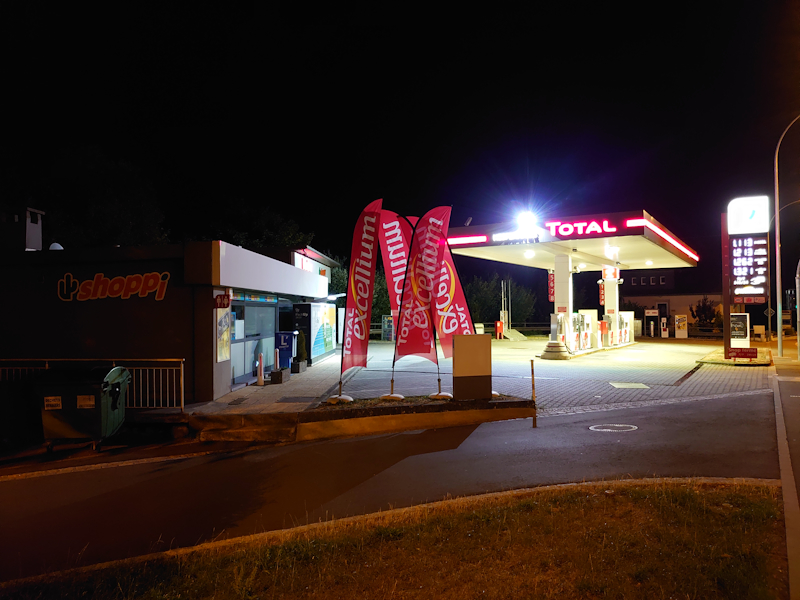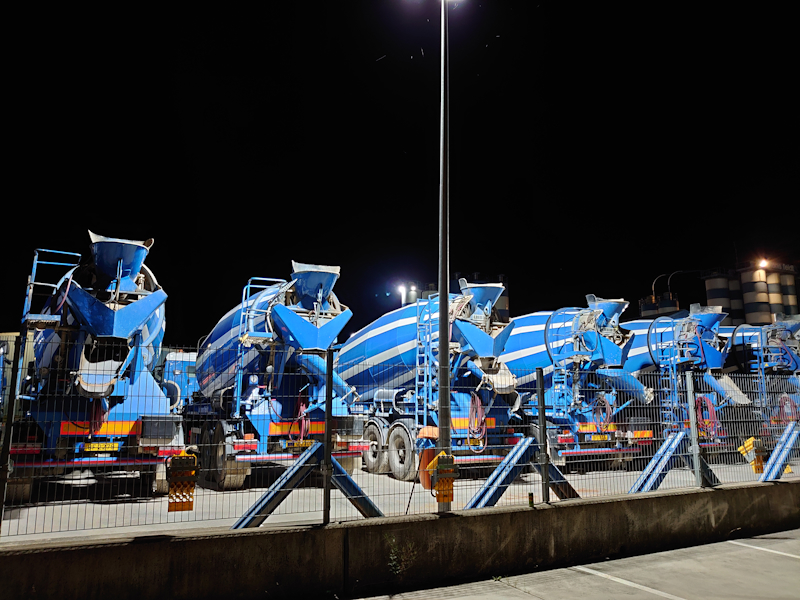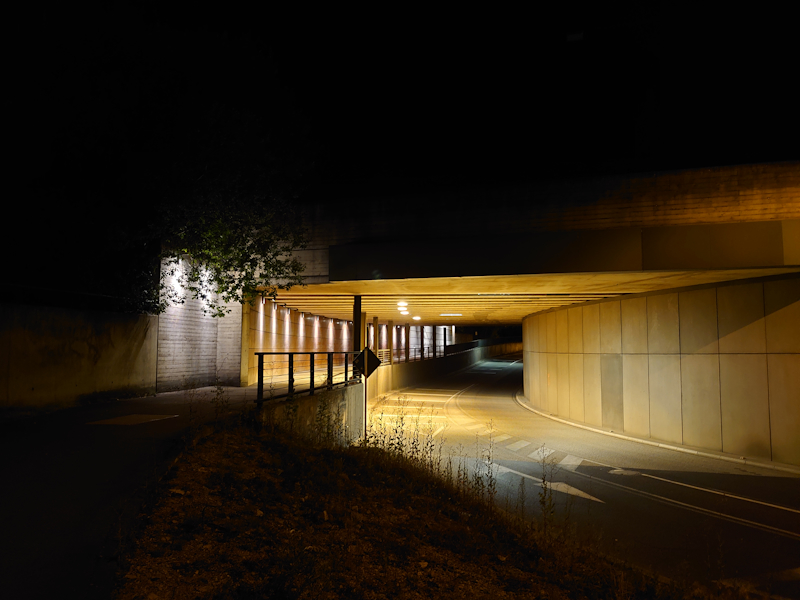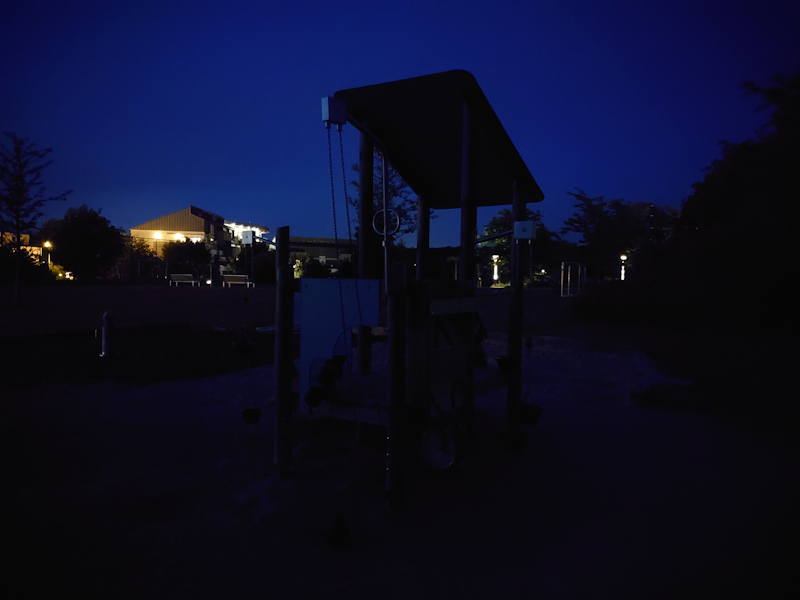The Sony Xperia 1 Review: A 21:9 Take of the World
by Andrei Frumusanu on July 26, 2019 8:00 AM EST- Posted in
- Mobile
- Sony
- Smartphones
- Xperia 1
Camera - Low Light Evaluation

[ Xperia 1 ] - [ S10+ (E) ] - [ S10+ (S) ]
[ P30 Pro ] - [ G8 ] - [ Pixel 3 ] - [ iPhone XS ]
In the first shot here, it’s a typical situation where a camera which only has a certain level of limited dynamic range, has to choose between exposing between the darker parts or the highlights of the scene. The Xperia 1 chose to go for exposing more for the shadows which has the adverse effect of really blowing out the highlights.
Unfortunately Sony here can’t compete with other phones which just have better and wider dynamic range processing – for example Apple’s iPhone XS manages a significantly better result.
The phone is already bottom barrel as it is, however against phones with dedicated night modes it’s no longer much of a competition.
On the wide-angle the dynamic range is still bad, however Sony’s detail preservation as well as noise reduction is top notch, while other phones end up with quite blurred out and ugly noise reduction.

[ Xperia 1 ] - [ S10+ (E) ] - [ S10+ (S) ]
[ P30 Pro ] - [ G8 ] - [ Pixel 3 ] - [ iPhone XS ]
In more artificially lit scenarios such as this one, the composition differences between the phones are relatively small. The biggest difference remains detail, and notice how the Xperia manages to preserve the dirt on the foreground wall.
The wide angle continues to show a dynamic range weakness and it blows out highlights too much.

[ Xperia 1 ] - [ S10+ (E) ] - [ S10+ (S) ]
[ P30 Pro ] - [ G8 ] - [ Pixel 3 ] - [ iPhone XS ]
This scene was a disaster for the Xperia 1 as the stabilisation didn’t manage to get a clear shot and there’s lots of blurring due to longer exposures both on the main and wide angle. It’s a pretty bad result.

[ Xperia 1 ] - [ S10+ (E) ] - [ S10+ (S) ]
[ P30 Pro ] - [ G8 ] - [ Pixel 3 ] - [ iPhone XS ]
Here we also see the phone struggling with dynamic range and it’s just not able to get sufficient light into the sensor.

[ Xperia 1 ] - [ S10+ (E) ] - [ S10+ (S) ]
[ P30 Pro ][ G8 ] - [ Pixel 3 ] - [ iPhone XS ]
In dim indoor light, the phone still struggles to get much light in, so while details are alright, the exposure isn’t sufficient. The competition’s night modes are just way ahead.

[ Xperia 1 ] - [ S10+ (E) ] - [ S10+ (S) ]
[ P30 Pro ] - [ G8 ] - [ Pixel 3 ] - [ iPhone XS ]
Finally while in extreme low light, even though goes into a special mode, it seems to be all that this does is capture longer exposures, and there’s not too much in way of computational photography.
Low-light Camera Conclusion
While the Xperia 1 has good noise reduction and detail preservation, its lack of dynamic range is extremely evident in low light as it just can’t deal with many scenarios as well as the competition can. The phone actually performs worse than the iPhone XS which is a bad place to be at, as it means that the device definitely can’t keep up with other Android devices which have developed their computational photography capabilities.










75 Comments
View All Comments
doungmli - Friday, July 26, 2019 - link
I do not think that the creator mode of x1 is supposed to respect a norm but to create a new one trying to reflect the content of the creator if the translation has been done. There was an interview about it here: https://www.phileweb.com/interview/article/201907/...vortexmak - Friday, July 26, 2019 - link
I opened this article with cautious optimism. Sony trying to make a comeback, maybe they learned from their past mistakesScrolled down: No 3.5mm jack, no microSD. Never learn Sony , enjoy your fall into oblivion
No headphone jack , no microSD = no consideration.
qwertymac93 - Friday, July 26, 2019 - link
The phone does have a microSD slot.khanikun - Monday, July 29, 2019 - link
I wouldn't say Sony is trying to make a comeback, they never left. It's just them combining divisions. They've been making smartphones every year.Also all their flagships have microSD slots and this one doesn't change that fact. 3.5mm jack was taken out the last generation. I wish they wouldn't have though.
Sp12er - Friday, July 26, 2019 - link
Nice concise, but detailed and easy to understand review, it sums up what's the strength an weakness of the device with clear proof given, I start to like this one, IMO you did it better than Gsmarena does.So it's all software eh? Sony seems to hav tee hardware nailed on so many levels, but the software feels like it's trying to catch up, no computational imaging, weird calibration, overexcited marketing.
All overall makes it an underperforming device for the price.
But, it makes me excited for their future. I hope they'd continue add soldier on with their software, getting it closer to the standard with more time.
1_rick - Friday, July 26, 2019 - link
"the screen is 6.5” in diameter"A round cell phone--that's pretty innovative! Not sure if it's a good idea, though.
qlum - Friday, July 26, 2019 - link
I think we should really stop using screen diagonal for size as it really only works if aspect ratio is fixed. screen surface area would be a much better measurement.Lord of the Bored - Saturday, July 27, 2019 - link
Yes, but how would marketing departments make screens sound bigger than they are?kendytan - Friday, July 26, 2019 - link
https://youtu.be/sJk7XeX1uJ8Please watch YouTube video on the link above 10:09 mark. Hong Kong expert tested Xperia 1 and get average 0.53 value using CalMan. Suggested white balance to achieve D65 by expert: Red 72, Green 68, Blue 0
Andrei Frumusanu - Friday, July 26, 2019 - link
He's measuring the saturation against a higher gamma target and that's why gets gets a lower dE. Furthermore he's in the standard mode.Lastly, his result are very likely wrong depending on how he measured them. The issue with the calibration is the luminance factor which is affected by APL. I measured the greyscale and saturations at APL50 window 50 to minimize the impact, and the GMB tests are done on a single static image pattern which is 100% accurate.